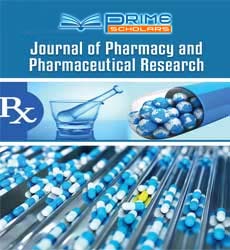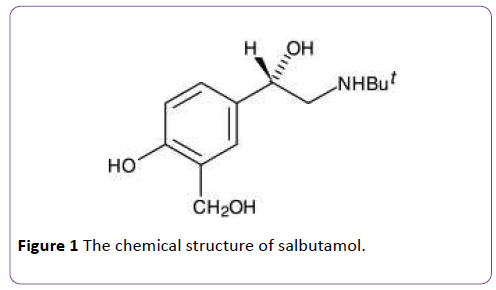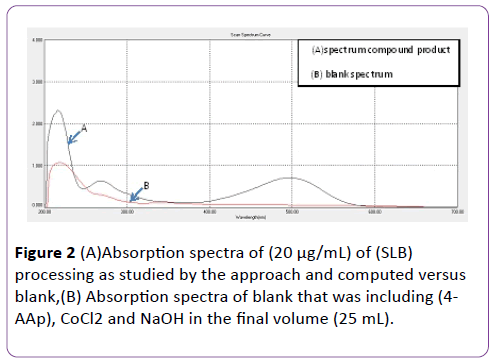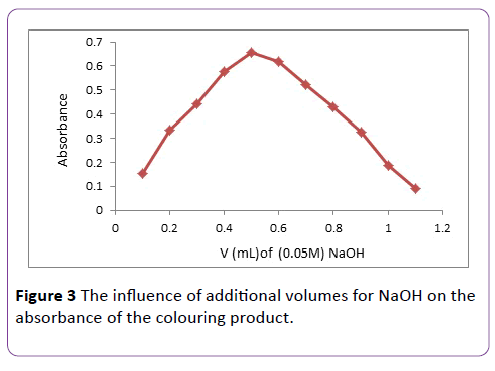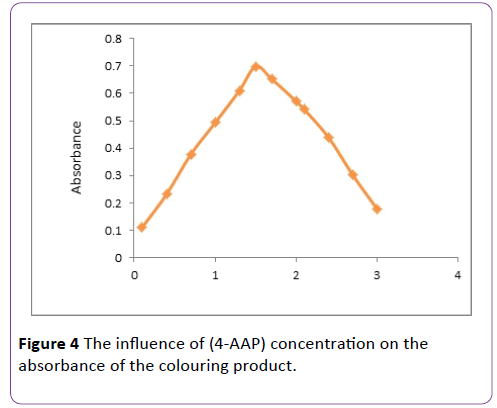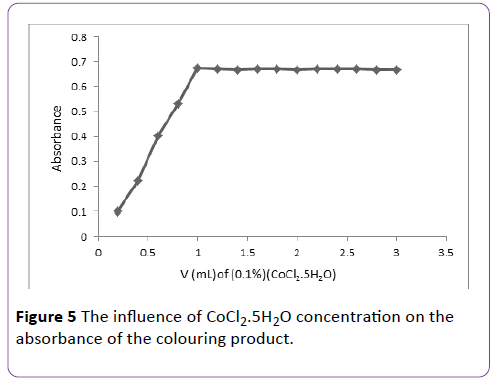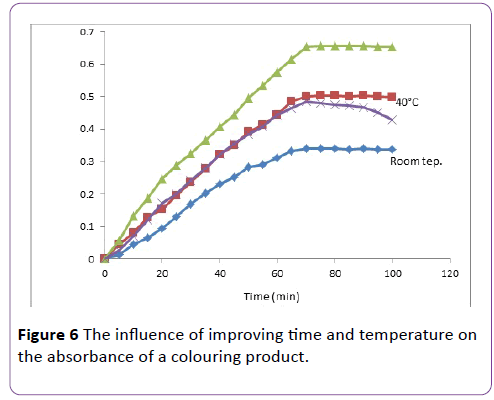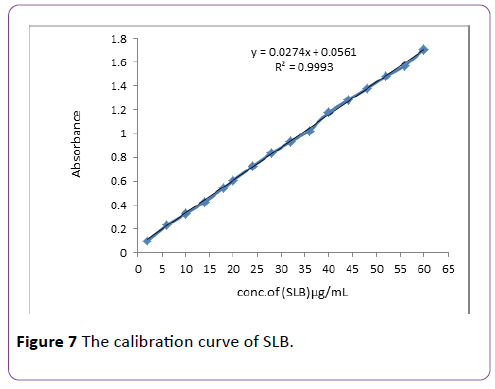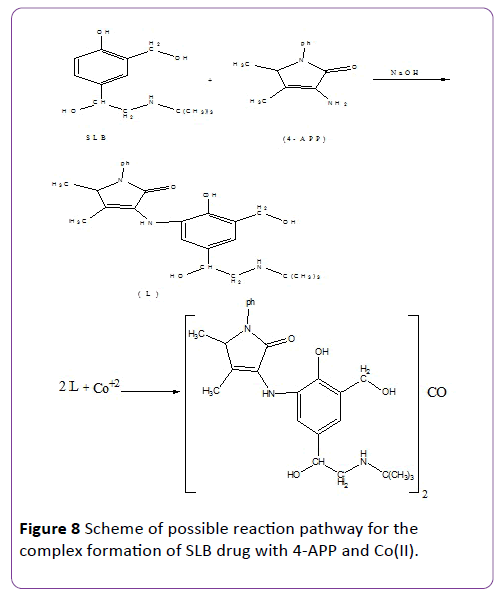Keywords
Colorimetric; Estimation; Salbutamol sulphate;
Pure form; Types of pharmaceutical
Introduction
Salbutamol sulphate (SLB), IUPAC name was bis[(1RS)-2-[(1,1-
dimethylethyl) amino]-1-[4-hydroxy-3-(hydroxyl methyl) phenyl]
ethanol] sulphate (Figure 1), it is a 2-sympathicomimetic drug
which was used as drug in the markets in 1973s [1]. It is too
known as albuterol. SLB is utilized at first in the bronchial
asthma treatment, it is applied as drug for the other types of the
disease of allergic airways, and it is worked as a β2 adrenergic
receptor agonist. So SLB is acted as its cardiovascular, and a
bronchodilator influences are smaller than its bronchodilator
actions drug is utilized in obstetrics forth on the premature
labour prevention also as a nasal decongestant [2-4].
Figure 1: The chemical structure of salbutamol.
Soluble freely in water, very slightly soluble or practically
insoluble in ethanol (96 %) also in the methylene chloride [5].
Different approaches have been utilized for the estimation of
SLB, involving liquid chromatography-tandem mass
spectrometry [6], high performance liquid chromatography
[7-9], the gas chromatography conjugated with mass
spectrometry [10] flow injection analysis [11], polarographic [12]
derivative ultraviolet spectrophotometry [13], capillary
electrophoresis [14] and the spectrophotometric (colorimetric)
methods [15].
The colorimetric estimation procedures of (S such as chargetransfer
complex formation [16], LB) in pharmaceuticals were
dependent on the simple chromogenic diverse reactions
diazotization coupling reaction [17], redox [18,19], reduction
followed by chelation [20], oxidative coupling [21,22],
nitrosation [23] and nitration [24].
The current investigation is aimed mainly for development A
new sensitive, simple and accurate colorimetric approach for the
estimation of salbutamol depended on the coupling between
the drug with (4-AAP) to obtain a newly ligand that combined
with cobalt (II) to produce highly intensity red colour complex at
60°C. The approach is applied in pure drug form and in different
types of pharmaceutical with highly precision and accuracy.
Materials and Methods
Experimental apparatus
Every spectral measuring's were performed on double-beam
UV-Visible 160 recording digital spectrometer (Japan) and using
1 cm silica cells, ice-water bath, sensitive balance ,pH meter,
Jenway 3020.
Chemicals and reagents
All substances utilized were of analytical grade and it was
received from BDH and Fluka companies, the pure drug
salbutamol sample was supplied from SDI Company, Samara,
Iraq. Dosage forms were received from commercial resources.
Sodium hydroxide solution (0.05 M) was made by dissolution
(0.2 g) of (NaOH) in deionized water after that palliated to (100
mL) in the volumetric flask.
Cobalt chloride (CoCl2.5H2O) (0.1%) solution was made by
dissolution (0.1 g) of cobalt salt with deionized water and
palliated to 100 mL in the volumetric flask.
(4-AAP) 4-Aminoantipyrine (1%) made by dissolution (1 g) of
(4-AAP) in little quantity of ethanol and palliated to the label in
100 mL calibrated flask with deionized water.
Salbutamol (standard solution) of (500 μg/mL) was made by
dissolution 0.05 g of SLB pure in deionized water and palliated to
the label in 100 mL calibrated flask with deionized water and
putted in black container and leave in the refrigerator. This
solution was utilized in the next experiments.
Procedure for pure drug
Standard volumes (0.1–3 ml) from (500 μg/mL) of pure SLB
drug, were transmitted into a chain of 25 ml calibrated flasks,
after that added 1 mL of 0.1% cobalt salt,1.5 mL of 1% 4-AAP,
and 0.5 mL of 0.05 M NaOH. The mixture was putted in the
water bath checked for 70 min at 60°C. The red complex was
produced, achieved and cooled to 25 mL with deionized water,
the absorbance values were computed at 500 nm versus the
blank solution. The color for the dye formed is stable for the
next day.
The working curve was built by utilizing the above approach
utilizing standard drug solutions.
(0.5-3 mL) volumes=(2-60 μg/mL) concentration
Sample preparation procedure
Tablets samples: Finely powdered and weighed 20 tablets
from kind of tablets (each tablet including 2 mg of salbutamol)
[25]. A powder amount was equivalent to 0.05 gm from each
SLB was accurately weighed and transmitted into a beaker (50
ml). The completely powder was dissolute in deionized water
and the filtered solution was through a filter paper Whatmann.
After that filtering to remove the non-dissolute ingredients it
was transmitted in the (100 mL) volumetric flask and palliated to
the final volume by the deionized water. A drug solution liquid
was analyzed as examined in general approach.
Syrup sample: The contents of two bottles of SLB syrup
(Butadin®syrup) [each 5 mL from syrup contains 5 mg SLB] were
taken and mixed well, after that taken 125 mL from the syrup
solution that was containing 0.05 gm from the SLB. The standard
working solutions were made by appropriate palliation from this
solution and the recommended approach was utilized for the
estimation for albutamol.
Pressurized inhalation sample: Three canisters from
pressurized inhalation sample of SLB (Vental inhaler) [each
canister contains 0.02 mg SLB in 20 mL volume] were taken and
mixed well, after that taken 60 mL from the sample that was
including 0.05 gm from the SLB. The standard solution was
prepared by suitable dilution from this solution that was
analysed by the studied approach.
Result and Discussion
The optimization of the experiential circumstances influencing
the reaction of salbutamol with 4-AAP and cobalt chloride was
examined accurately (Figure 2).
Figure 2: (A)Absorption spectra of (20 μg/mL) of (SLB)
processing as studied by the approach and computed versus
blank,(B) Absorption spectra of blank that was including (4-
AAp), CoCl2 and NaOH in the final volume (25 mL).
Absorption spectrum
SLB reacts with 4-AAP to obtain a newly ligand in the
existence of sodium hydroxide that reacts with cobalt II to
produce strongly intensity red colour complex after the heating
for 70 min at 60°C, as appeared in Figure 2, the spectrum of
absorption of which under optimum circumstances gives a
maximum at 500 nm.
Medium influence
The medium of medium on the absorbance of the product
solution was examined; the basic medium was the best for the
reaction. bases like ammonia, ammonium hydroxide, sodium
hydroxide, potassium hydroxide and sodium carbonate were
realized and given that sodium hydroxide highly sensitivity than
other bases, that used in the examined approach, the influence
of additional volumes for NaOH As appeared by Figure 3, it was
showed that the highly absorbance for the chelating complex
product gave at λmax (500 nm) by utilizing 0.5 mL of 0.05 M
NaOH. So that the pervious constant amount of sodium
hydroxide was utilized in every next tests.
Figure 3: The influence of additional volumes for NaOH on the
absorbance of the colouring product.
Influence of the quantity of 4-AAP
By using constant quantity of the drug solution ,the different
concentrations of 4-AAP solution were utilized to the volume 1.5
mL from solution 1% was found sufficient to the colour
increasing of the product to give highly intensity (Figure 4), with
a minimal value blank also was assumed to be prefect.
Figure 4: The influence of (4-AAP) concentration on the
absorbance of the colouring product.
Influence of CoCl2.5H2O concentration
The colouring complex product was given with highly
absorbance when 1 mL of 0.1% concentration of CoCl2.5H2O
solution was utilized with a mixture of 4-AAP, salbutamol and
sodium hydroxide (Figure 5), so that, this quantity was utilized in
the approach since it obtains highly sensitivity and minimal
blank value.
Figure 5: The influence of CoCl2.5H2O concentration on the
absorbance of the colouring product.
Reaction time and temperature influence
The time of reaction was investigated by the showing of the
colour improvement at temperature of room and at various
temperatures in thermostatically controlled water-bath. The
absorbance was computed at 5 min periods versus reagent of
blank treated in the same method. As appeared in Figure 6, the
figure was saw that production of the product complex for SLB
was carried out ultimate at 60°C after 70 min and fixed for at
least 3 hour.
Figure 6: The influence of improving time and temperature on
the absorbance of a colouring product.
Order of addition influence
To get the prefect results, the addition order of reagents must
be pursued as obtaining by utilized the examined approach;
moreover a decrease in the colour intensity was noted.
Quantification
So as to estimate the concentration range for the coloured
product involve to the Beer's law, a computed absorbance of the
product was at the value of λmax (500 nm) after the color
increasing by utilized the examined approach for the solutions
sequence including increase quantities of SLB (Figure 7).
Sandell's sensitivity, molar absorptivity, and the Beer's law limits
were estimated and showed in Table 1, it was appeared the
sensitivity for the studied approach. The linear was computed
from the corresponding correlation coefficient also the
regression equation for SLB estimation into the studied
approach appears premium linearity. The accuracy (average
recovery %) and the precision (Relative Standard Deviation-RSD) for the five replicates analysis of every three various
concentrations for SLB (30, 15 and 5 μg/mL) showed that the
approach is accurate additionally precise. LOQ and LOD are
computed for the studied approach. Surely, the LOQ a little bit
passes the minimum of the Beer's law range. However, LOD is as
well as less the minimum of the Beer's law range [26].
Figure 7: The calibration curve of SLB.
| Parameter |
Values of approach |
| limits of Beer's law |
(2.0-60.0) (μg/ml) |
| Correlation coefficient |
0.9993 |
| Sandell's sensitivity |
0.036 (µg.cm-2) |
| Molar absorptivity |
0.6558×104 (L.mol-1.cm-1) |
| Limit of quantitation |
1.3412 (μg/ml) |
| Limit of detection |
0.5510 (μg/ml) |
| Regression equation |
(Y)* |
| Intercept |
b 0.0561 |
| Slope |
a 0.0274 |
| Average recovery |
100.23% |
| RSD** |
1.32% |
| *Y=a X+ b, where the concentration is X of (SLB) with (μg/mL) |
|
| **Five Average for the estimations |
|
Table 1: Synopsis of visual properties also the analytical
information for the examined approach.
Interference
The interferences ambit by several excipients that
predominatingly combined with the pharmaceutical dose forms
were examined by computing the absorbance for the solutions
including 20 μg/mL of SLB and every one of the excipients was
taken separately in concentration (200 μg/mL). It was tested by
utilizing the like approach in the calibration curve in the end
volume of 25 mL. The results showed that the examined
excipients do not influence in the estimation of salbutamol in its
dosage forms (Average of three estimations) (Table 2).
| Excipients |
% Error |
% Recovery |
| Acacia |
+ 2.400 |
102.400 |
| Talc |
- 3.100 |
96.900 |
| Glucose |
+2.200 |
102.200 |
| starch |
- 2.200 |
97.800 |
| lactose |
+4.100 |
104.100 |
| Vitamin C |
-3.400 |
96.600 |
| Sucrose |
+.2.250 |
102.250 |
| Glycerin |
2.850 - |
97.150 |
| magnesium stearate |
- 4.100 |
95.900 |
| PVP |
- 1.550 |
98.850 |
| Aspartate |
+ 2.100 |
102.100 |
| Sodium chloride |
- 2.650 |
97.350 |
Table 2: Investigation of 20 ppm salbutamol SLB in the being of excipients.
Structure of the product
It is obvious from the literatures [27-30] that a mole ratio and
continuous variation method (Job’s method) of phenolic
compound: 4AAP was 1:1 formation a new ligands existence
minimum absorbance. The absorbance sensitivity has been
improved by its reaction with Co(II) to give the intensity of color
for the resulting complex. By utilizing the continuous variation
method (Job’s method) and the method of molar ratio. The
results obtained appeared that the colored complexes with
stoichiometric ratio of 2:1 [4-AAP-phenolic drug] ligand:Co(II).
The obvious stability constant for the resulting complex were
computed by comparison the absorbance of solution that
involving equivalent amounts of new ligand [4-AAP-phenolic
drug] and Co(II) and other solution containing a five-fold excess
of Co(II) ion from the starting concentration. The perfect
amount for the utilizing solution was 1 mL of 2×10-3 M. The
average conditional stability constants the resulting complex in
water under the examined experiential circumstances is
5.34×105. The reaction may proceed as given in the following
scheme (Figure 8).
Figure 8:Scheme of possible reaction pathway for the
complex formation of SLB drug with 4-APP and Co(II).
Analytical Applications
The studied approach was felicitously utilized to estimate SLB
in its pharmaceutical dose forms. The results obtained were
made statistical comparison by a variance ratio (F-test) for
precision and a Student’s t-test for accuracy with the standard
approach [5] (basing on the titration for pure (SLB)
potentiometric ally by utilizing perchloric acid (0.1 M) at the
confidence level (95%) with five degrees of freedom, as seen in Table 3. The results appeared that the F-test and t-test were
below the theoretical value (F=6.39, t=2.31), pointing there was
no clear distinction between the examined approach and
standard approach (Average of three investigations) [31].
Furthermore, the studied approach is compared favourably with
other reported approaches as appeared in Table 4.
| SLB pharmaceutical preparations |
Examined approach |
Standard |
Nominal Values (t),(F) |
| approach |
| Recovery% |
RSD% |
Recovery% |
RSD% |
| Pure salbutamol |
100.23 |
1.32 |
99.92 |
1.21 |
(F)Value=1.93
(t)Value=1.07 |
| Butadin (tablets) (2mg/Tab) S.D.I,Iraq |
99.84 |
1.83 |
99.77 |
1.66 |
| Butadintablets (2mg/Tab) (Dijla),Iraq |
100.44 |
1.65 |
99.89 |
1.04 |
| Butadin (syrup) (2mg/5ml) S.D.I,Iraq |
100.04 |
1.21 |
99.93 |
1.21 |
| Vental inhaler(SLB) (0.1/DOSE) (Arab drug company) Cairo,Egypt |
100.14 |
1.51 |
99.88 |
1.47 |
Table 3: Estimation of (SLB) in pharmaceutical dose forms utilized the examined approach and comparing with the standard approach.
| Reagent used |
Λmax (nm) |
Beer's law limit (μg.ml-1) |
Molar absorptivity (L.mol-1cm-1) |
Application |
Remarks |
| Cerium(IV)– MBTHa [18] |
530 |
0-15 |
2.4×10-4 |
- |
contains extraction and an expensive reagent |
Ferricyanide 4-
Aminophenazone
[32] |
505 |
25-175 |
- |
- |
Heating waiting, for 30 min |
Diazotized 4-
minoacetophenone [33] |
463 |
0.5-30 |
2.72×10-4 |
Tablet, syrup |
- |
Chloramine-T
N,N-Dimethyl-pphenylenediamine [34] |
620 |
Oct-40 |
- |
|
Extraction with |
Diazotized
o-nitroaniline [35] |
448 |
Feb-40 |
1.58×104 |
Tablet, syrup |
|
| BrO3 ––Br– /methyl orange [21] |
510 |
0.5-5 |
7.17×104 |
Tablet |
Includes somereagents and
difficultconditions |
| F–C reagentb [16 ] |
750 |
Jan-15 |
------- |
Tablet, urine |
Uses flow injection and
extraction |
| sodiumcarbonate,hydroxylammonium [36] |
701 |
100-500 |
6.24×103 |
Tablet, injection |
- |
| diazotized 2,4-initroaniline [37] |
558 |
02-Jun |
9.33×104 |
Tablet, syrup |
- |
| 4-AAP-Co |
500 |
Feb-60 |
0.6558×104 |
Tablet, syrup
Vental inhaler |
Examined approach |
aMBTH, 3-methylbenzothiazolin-2-one hydrozone
b Folin–Ciocalteu reagent, F–C reagent
Table 4: Comparing of results for the estimation of SLB by the examinedapproach and the reminded approaches.
Conclusion
The studied approach is fairly sensitive, simple and economic
when comparison with previously reported approaches specially
those established on non-aqueous midst and costly technicality
such as HPLC that do not need any treatment for the drug or the
approach of extraction and give a perfect precision and
accuracy. The approach is necessary for the estimation of
pharmaceutical specimens of SLB (syrup and tablet), and the
producing data founded there is no interference with the
additive existent in common dose forms.
References
- The British Pharmacopoeia (1998) Her Majesty’s Stationery Office London pp:1151-1156.
- Gilman AG, Goodman LS, Rall TW, Murad F (1985) Goodman and Gilman's the Pharmacological Basis of Therapeutic 7: 172- 174.
- Han X, Xu JYC (1997) facts that influence accumulation of antioxidant compounds in aromatic plants. YaowuFenxiZazhi 17: 11.
- Goth MDA (1981) Medical pharmacology.CV Mosby, London.
- The British Pharmacopoeia (2009) Her Majesty’s Stationary Office, London pp:5345, 9953, 9961, 9965.
- Munoz P, Blanca J, Ramos M, Bartolome M, GarciaE, et al. (2005) Liquid Chromatographic Determination of Amoxicillin Residues in Grouper Muscle Following Oral Administration of the Veterinary Drug. Analytical ChimicaActa 529:137.
- Salari H, Eigendorf GK (1990) Detection of lso-platelet-activating factor by high-performance liquid chromatography after reprivatisation with fluorescent fatty acids. J Chromatogr 18: 303-314.
- Isabel D, Moises K (2004) Low injection spectrophotometric determination of salbutamol with 4-aminoantipyrine. Talanta15: 1233-1236.
- Ozkan SA, Uslu B, Aboul-Enein HY (2007) Analysis of pharmaceuticals and biological fluids using modern electroanalytical techniques. Critical Reviews in Analytical Chemistry 33: 155.
- Al-Abachi MQ, Al-Delami AMS, Al-NajafS (1988) Diazotized 4-aminoantipyrine as a chromogenic reagent for the spectrophotometric determination of trace amounts of N-(1-Naphthyl) ethylenediamine in aqueous solution. Analyst 133: 1661.
- Al-Abachi MQ, Ahmad A K, Flayeh KA (1990) Spectrophotometric micro determination of some sulphonamide drugs after diazotization and coupling with Indole. Iraqi J Sci 31: 265.
- Rodriguez LA, Romero LA, Tena IE, Coque MCGA (1999) development determination of salbutamol in drug forms.J of AOAC 82: 937.
- Mukherji G, Aggarwal N (1991) Derivative UV-spectroscopic determination of salbutamol sulphate in the presence of gelatine. Int J Pharm 71: 187.
- Altri K D (1993) Application and development of ion chromatography for the analysis of transition metal cations in the primary coolants of light water reactors. J Chromatography A 13: 323.
- BasavaiahK, Prameela HC (2003) Spectrophotometric determination of salbutamol sulphate (SBS) and pyrantelpamoat (PRP) in Bulk drugs and pharmaceuticals. Chem Anal 48: 327.
- Sadler N P, Jacobs H (1995) Application of the Folin-Ciocalteau reagent to the determination of salbutamol in pharmaceutical preparations. Talanta 42: 1385.
- Al-Sabha T N (2007) Colorimetric assay of salbutamol in pure form.J EducSci 19: 25.
- Reddy MN, Sankar DG, Rao GD, Sreedhar K (1991) Determination of salbutamol by charge transfer reaction ,in pure form and drugs samples. East Pharm 34: 127.
- Basu M, Pathak B (1990) Oxidation reduction reactions application on the assay of phenol drugs compounds as pure form. Indian Drugs 28: 109.
- Geetha N, Baggi TR (1889) An improved spectrophotometric method for the determination of salbutamol sulfate with 3-methylbenzthiazolinone-2-hydrazone. Microchem J 39: 137.
- Vishwanth KK, Rao AS, Shivaramakrishnan MV (1989) Determination of salbutamol in dose forms by using oxidative coupling reactions. Indian Drugs 26:516.
- Patel RB, Patel AS, Pallavi U (1987) New method for the assay of salbutamol in pure form by nitrosation coupling reactions. Indian Drugs 24: 298.
- Sanghavi NM, Vyas JT (1998) determination of salbutamol by using nitration coupling reaction. Indian Drugs 34: 463.
- US Pharmacopoeia XXIIth Rev (2007) US Pharmacopoeia Conventionp: 1094, 2295.
- Zorn EM, Gibbons DR, Sonzogni CW (1997) Simultaneous estimation of cetirizine hydrochloride and salbutamol sulphate in pharmaceuticaldosage forms. Anal Chem 69: 3069.
- Allah HHA (2006) Spectrophotometric-Flow injection Determination of Amoxicillin in Pharmaceutical Preparations, M. Sc. Thesis, Baghdad University.
- Al-Kafagi MJH (2003) Pharmaceutical Analytical Applications using Flow Injection spectrophotometry. M. Sc. Thesis, Baghdad University.
- Beyene NW, Staden JFV (2004) Sequential injection spectrophotometric determination of phenylephrine hydrochloride in pharmaceutical preparations. Talanta 63: 599.
- Al-Rufaie MM, Al-Sharefy AN,Kathem KH (2013) Spectrophotometric Determination of Doxycycline Hyclate in Pharmaceutical Preparations Using Oxidative coupling reaction. J Apple Chem 2: 931.
- Al-Rufaie MM (2014) New spectrophotometric method for determination of drug compounds based on the oxidative coupling reaction and applied to some pharmaceutical preparations. Ph.D. Thesis, Babylon University.
- Talwar N, Singhai AK, Shakya AK, SarafS, Jain NK (1991) Colorimetric assay of salbutamol by using new chromogenic reaction. Indian Drugs 28: 244.
- Al-Abachi MQ, Hadi H, Hammza RA (2008) Developed spectrophotometric determination of salbutamol sulphate in pharmaceutical samples by coupling with diazotized 4-aminoacetophenone. Journal of Al-Nahrain University 11: 62.
- Sankar DG, Sastry CSP, Singh NRP (1987) Colorimetric assay of salbutamol sulphate by using azo coupling reaction. Indian Drugs 24: 410.
- HadiH (2008) Developedspectrophotometric determination of salbutamol sulphatein pharmaceutical samples by couplingwith O –Nitro aniline. Iraqi J of Sci 49:12.
- Manasa A, Mohammed A, Krantisudha S, Sudheerbabu I (2013) Spectrophotometric determination of salbutamol in bulkform andin various dosage forms. The Experiment 7: 445.
- Saleem MS, Al-Mtwaiti S M, Al-Ramadhani ST (2013) Spectrophotometric determination of Salbutamol sulphate by coupling with diazotized 2,4-dinitroaniline. J Edu and Sci 26: 54.
